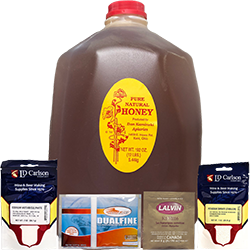You, Mead, and a Journey Through Time
Posted by Matteo Lahm on 3rd Oct 2023
If you like to make wine and beer but you want to give something complete different a try, you might want to venture into the world of mead! If you've got a taste for the extraordinary, a thirst for the historical, and a healthy inclination for curiosity, it just might be yet another tasty beverage you can add to your drink menu. Mead, that golden elixir of yore, has been tickling palates and sparking intrigue for millennia.
So, where did this delightful brew first make its appearance? You might be surprised to learn that mead's origins are as hazy as a glass of unfiltered honey wine. Some say it was first made in ancient China, others argue it was Africa, while a few insist it was the frosty climes of Northern Europe. The truth? It's probably as mixed as a well-balanced batch of mead.
Now, let's take a step back in time, to when mead was at the height of its popularity. Picture yourself in the Middle Ages, a time when mead was as common as water. It was the drink of choice for everyone from kings to commoners. But why was it so popular? Well, you see, mead was easy to make, and honey, its primary ingredient, was abundant. Plus, it had a taste that was, quite simply, irresistible.
Speaking of taste, you're probably wondering what mead tastes like. Imagine the sweet, floral notes of honey, the tartness of fermented fruit, and the warmth of alcohol, all dancing together in a harmonious blend. That's mead for you. But remember, just like you, each batch of mead is unique, reflecting the characteristics of the honey and other ingredients used.
So, how do you make mead? It's simpler than you might think. At its core, mead is a concoction of honey, water, and yeast. But let's delve a little deeper, shall we?
First, let's talk about honey. The star of the show, honey is what gives mead its characteristic sweetness. The type of honey you use can dramatically alter the flavor of your mead, so choose wisely. From the light, floral notes of clover honey to the robust, earthy tones of buckwheat honey, the possibilities are as varied as they are exciting.
Next up, water. While it might seem like a mundane ingredient, water plays a crucial role in mead making. It dilutes the honey, making it easier for the yeast to do its job. The quality of your water can affect the taste of your mead, so make sure it's clean and free from any off-flavors.
Now, let's talk about yeast. This humble microorganism is the engine that powers the fermentation process. It feasts on the sugars in the honey, converting them into alcohol and carbon dioxide. But not all yeasts are created equal. Some are better suited for mead making than others. Wine yeasts, for instance, are a popular choice among mead makers. They can tolerate high levels of alcohol and are known for their ability to bring out the nuanced flavors of the honey.
Speaking of alcohol, you're probably wondering about the standard ABV (Alcohol By Volume) of mead. While it can vary depending on the recipe and fermentation process, most meads typically fall in the 10-18% ABV range. This makes it stronger than most beers but slightly less potent than spirits like whiskey or vodka.
When it comes to fermenting mead, the choice of yeast is crucial. The yeast not only kickstarts the fermentation process but also influences the flavor, aroma, and alcohol content of the final product.
Wine yeasts are often the go-to choice for many mead makers. They are known for their ability to tolerate high levels of alcohol, typically up to 15% ABV, and can bring out the nuanced flavors of the honey. Some popular wine yeast strains used in mead making include Lalvin 71B and Lalvin D47. If you want to push that ABV to the threshold, you will need Lalvin EC-1118.
Lalvin 71B is a versatile yeast strain that's great for beginners. It ferments reliably and produces a mead with a rich, fruity character. Lalvin D47, on the other hand, is known for its ability to enhance the mouthfeel and complexity of mead, making it a favorite among more experienced mead makers. Lalvin EC-1118 is a powerhouse yeast that can ferment under a wide range of conditions and can reach an alcohol content of up to 18%.
Ale yeasts can also be used to ferment mead, especially if you're aiming for a lower alcohol content and a quicker fermentation process. They tend to produce meads with a more robust, malty character.
Remember, the choice of yeast can significantly impact the flavor and character of your mead, so it's worth experimenting with different strains to find the one that suits your taste the best.
So there you have it. Mead making might seem like a complex process, but once you understand the basics, it's as simple as mixing honey, water, and yeast, and letting nature take its course. The result? A beverage that's as intoxicating in its complexity as it is in its alcohol content.
But don't just take my word for it. Why not try making your own batch of mead? It's a fun, rewarding process that lets you tap into a tradition that's as old as civilization itself. And who knows? You might just discover a new passion.
So, there you have it. A brief, but hopefully enlightening, journey through the history of mead. Now, it's your turn to make history. Go on, uncork that bottle of mead, take a sip, and let the flavors transport you back in time. After all, you're not just drinking a beverage, you're savoring a piece of history.


